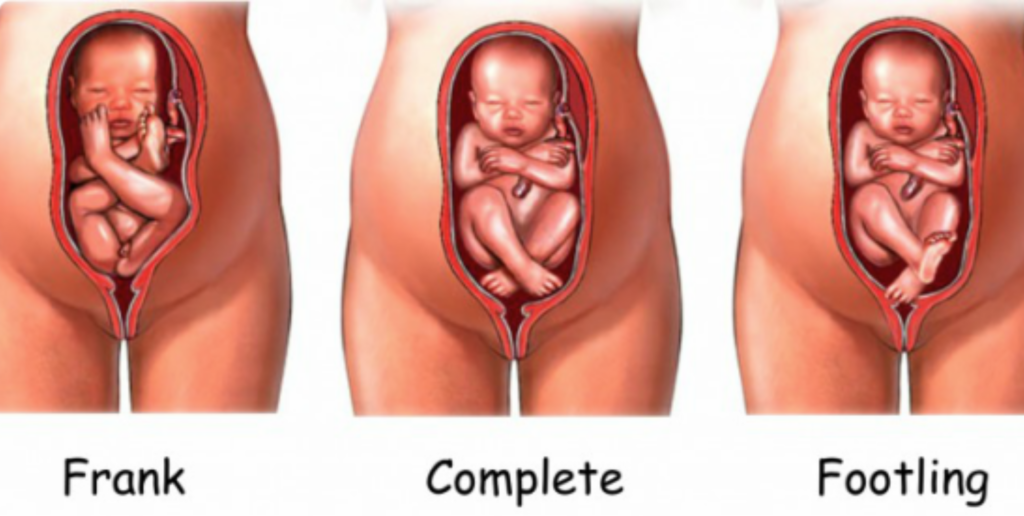
Vaginal Breech
Q: Can I have a vaginal breech birth at home?
A: Yes, vaginal breech birth can happen safely at home under the right conditions. Many women still do, and 50% of vaginally born twins will have one or more twin that is born breech. With careful planning, professional support, and appropriate screening to determine if you are a good candidate, many families successfully choose to have a vaginal breech birth at home. It is essential to work with an experienced provider who is knowledgeable about breech births and familiar with the evidence supporting safe home birth practices. Not all breech babies are in an ideal position to be born breech. There are risks in breech birth that differ from other vaginal births, but overall the evidence encourages support women who choose to birth vaginally , even when their baby is breech.
Q: How is a vaginal breech birth at home different from a hospital birth?
A: It is very much the same as any other homebirth. Oftentimes there will be an additional provider, as breech babes tend to take a bit longer to come around immediately after birth. This is normal and common for babies born breech. At home, there is less medical intervention available and each family must assess if this is the right choice for them, as a transport plan does not guarantee any particular outcome, but the evidence does demonstrate that the vast majority of breech birth will go nearly as well as the others, on the whole.
Q: Is there evidence that vaginal breech birth can be safe at home?
A: Yes, there is favorable evidence supporting the safety of vaginal breech birth when done with skilled attendants in well-prepared settings. Research, including studies and publications by experts such as Breech Without Borders, has shown that planned vaginal breech births, when attended by trained professionals, can result in positive outcomes for both the birthing person and the baby. While breech births can occasionally be more complex and require specific expertise, most complications can be easily resolved at home with few exceptions.
Q: How does the midwife ensure the safety of a breech birth at home?
A: There are no guarantees, as with anything we do in this lifetime, but breech-trained providers receive special education on breech maneuvers to assist in bringing down the arms of the baby, if needed, and helping to flex the baby’s head for the safest delivery possible. The vast majority of the time these maneuvers are not necessary and the birth can proceed unhindered, but providers trained in breech will be watching for signs of possible necessary intervention. Signs may include a baby that is not performing tummy crunches, has a very limp, pale cord, arms that are up over the head and not dropping down as expected, and a baby that is not aligning properly in the pelvis to allow for the most gentle delivery of the head. As with any other delivery, the provider is watching for signs that the baby may need help breathing after birth. This is expectedly more common with breech deliveries, but most babies will do great with just some gentle stimulation and a moment to catch their breath, literally.
Q: How do I know if I’m a good candidate for a vaginal breech birth?
A: Vaginal breech birth can be a safe and reasonable option for many women when carefully considered and supported by a skilled practitioner. However, this decision should be made based on individual factors and after an informed consultation. It’s important to understand that, like any birth choice, the ideal candidate for vaginal breech birth is someone who meets certain criteria and feels confident in their decision.
Q: What factors make someone a good candidate for a vaginal breech birth?
A: Research suggests that vaginal breech birth can be safe under specific conditions. These include:
1. Frank breech or complete breech position
2. Estimated fetal weight between roughly 5.5 lbs and 8.8lbs
3. A flexed head position
4. No fetal anomalies or major health issues
5. Normal maternal pelvis (potentially determined from prior vaginal delivery)
6. Gestation age between 37 and 42 weeks
7. Spontaneous start of labor with a reassuring heartrate
8. Mom and her support team feel confident in the unconventional choice and trust the process of normal physiological breech birth
When these criteria are met, the likelihood of a successful and safe vaginal breech delivery is high. However, each pregnancy is unique, and it’s essential to consult with an experienced provider to weigh the risks and benefits of all options.
Q: Why are there so few practitioners who offer vaginal breech birth?
A: Many doctors and midwives no longer have the training or expertise to safely manage vaginal breech deliveries. Some may prefer a cesarean section, believing it to be safer despite research suggesting otherwise. This trend is influenced by the current healthcare environment, which often prioritizes efficiency and safety from a legal or economic standpoint over individualized care choices. This lack of experience and willingness among many practitioners has made vaginal breech delivery less common, even though evidence supports it as a reasonable choice for selected women.
Q: How should I approach the decision of whether to have a vaginal breech birth or a cesarean?
A: The decision should be based on careful consultation with an informed practitioner. Start by gathering information, seeking a provider who supports your choice, and discussing all options. It’s also important to assess your personal feelings about birth, as this will influence your decision. Some women feel strongly about experiencing labor and a vaginal birth, while others may prefer the certainty and perceived safety of a cesarean. This is a deeply personal decision, and there is no one “right” choice. The key is having time to reflect, receive information, and feel supported in your choice.
Q: What non-invasive techniques can help with a breech baby?
A: Before making decisions about delivery, several techniques can be used to encourage a breech baby to turn to a head-down position. These include acupuncture with moxibustion, chiropractic adjustments, and certain exercises or postures. If these methods don’t result in the baby turning, you may consider an external version (manual turning of the baby), typically around 37 weeks. If these attempts are unsuccessful or not a good fit for your situation, you can then explore the possibility of vaginal breech birth.
Q: What if my baby doesn’t meet all the criteria for vaginal breech birth?
A: If any of the key criteria for a vaginal breech birth aren’t met (e.g., abnormal fetal position, inadequate pelvic size, or concerns about the baby’s health), a cesarean section may be the safest option. It’s crucial to follow the guidance of your care provider and make decisions based on the safety of both mother and baby. In situations where the criteria for vaginal breech birth are met, you may still choose to wait and see how labor progresses naturally.
Q: Can I still have a vaginal breech birth if I have a practitioner willing to support me?
A: While finding a skilled practitioner who is willing to support a vaginal breech birth can be challenging due to the decreasing number of professionals trained in this area, the demand for such options is crucial. If you meet the criteria and feel informed and supported, a vaginal breech birth can be a safe option. If your practitioner is not comfortable with this choice, it may be necessary to seek out a more experienced provider who has the skills and confidence to support you through the process.
Ultimately, the key is a supportive environment where you feel confident and well-informed. Each woman’s experience with breech birth is unique, and your feelings about labor and delivery should be respected as part of the decision-making process.
Q: What if I need to transfer to the hospital during a breech birth at home?
A: While the goal is always a safe, peaceful birth at home, some situations may require transferring to the hospital. Your midwife will develop a transfer plan with you well before labor begins, ensuring that everyone involved knows the steps to take should the need arise. Breech birth, while safe in many cases, does require the experience and quick decision-making skills of a trained professional, which is why knowing when to seek hospital care is an important part of the process. Most planned breech births at home will not involve a hospital transport, thankfully.

RESOURCES ON BREECH BIRTH
Breech Without Borders
A nonprofit organization dedicated to improving outcomes for breech births worldwide, Breech Without Borders provides training, research, and resources on the safe management of breech birth, including at home. Be sure to visit their Facebook page here. Providers should enroll in their classes and purchase their book Guide to Physiological Breech Birth.
Birthing Instincts
Birthing Instincts, has a wonderful podcast that discusses many topics around birth, including breech birth, as well as the Reteach Breech Initiative where providers can learn hands-on with Dr. Stu in a two-day workshop. The site emphasizes supporting families through informed decisions and empowering birth choices, with a special focus on breech presentations.
Website with great breech resources from providers on the other side of the world. You may be interested to check out the Infosheet on Deciding whether to Birth Breech.
The Breech Birth Handbook by Laurie A. Boucke
A comprehensive resource on breech birth, written by an experienced midwife. This book offers evidence-based information and practical advice for families considering breech birth at home or in other settings.
Spinning Babies
A well-known resource that focuses on optimizing fetal positioning for birth, Spinning Babies offers techniques and information that support safer vaginal breech birth, as well as turning breech babies into optimal positions. Here you can order the digital version of Breech Birth Quick Guide.
Evidence-Based Birth
Offering research-based information on various birth topics, including breech birth, Evidence-Based Birth covers the latest studies on the safety of breech deliveries, providing families with the tools they need to make informed decisions.
Midwifery Today
Midwifery Today offers articles, workshops, and online resources focusing on the safety and management of breech births, particularly in home birth settings. Their content is designed to support both families and midwives.
Coalition for Breech Birth– Facebook Group
Grassroots organization advocating for the return of vaginal birth to the normal options offered to women with breech babies. We are an interdisciplinary group, delighted to welcome parents, doctors, midwives, doulas, and all other professionals and individuals with an interest in supportive discussions around vaginal breech birth.
A phenomenal breech freebirth shared with the world by LucyProud in IG:
“The most important thing a woman needs during labor is not a set of medical tools and interventions, but the presence of someone who believes in her.”
– Khadijah Cisse, Midwife

